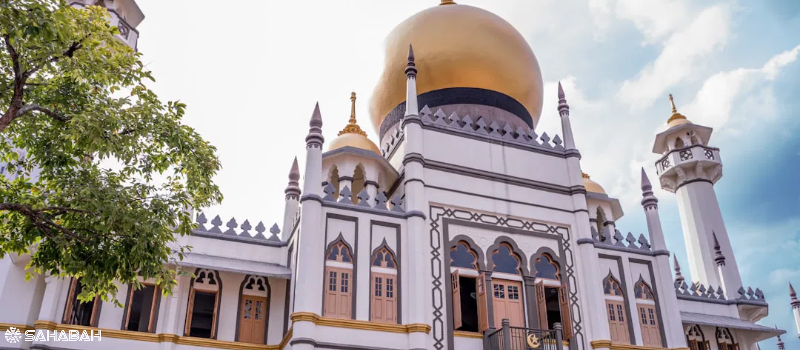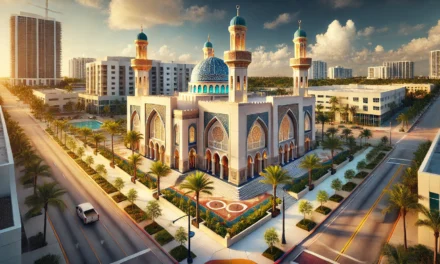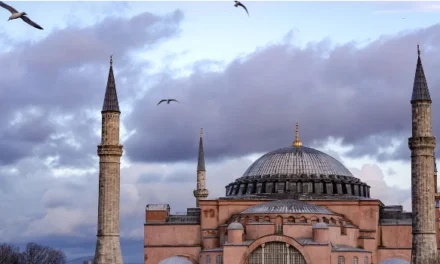Imagine standing before a breathtaking structure with golden domes that shimmer in the sunlight, surrounded by the vibrant culture of Singapore’s Malay community. This is the iconic Sultan Mosque, also known as Masjid Sultan, a magnificent architectural marvel that stands as a testament to Singapore’s rich Islamic heritage and multicultural harmony.
Located at 3 Muscat Street, Singapore 198833, in the heart of the historic Kampong Gelam area, Sultan Mosque is more than just a place of worship. It’s a national monument, a focal point for the Muslim community, and a must-visit destination for anyone interested in Singapore’s diverse cultural tapestry.
In this comprehensive guide, we’ll take you on a journey through the history, architecture, and cultural significance of Sultan Mosque. From its humble beginnings to its status as a beloved landmark, we’ll explore every facet of this extraordinary place that has captivated visitors for nearly two centuries.

The Rich History of Sultan Mosque Singapore
From Humble Beginnings to Architectural Marvel
The story of Sultan Mosque begins in 1824, when it was built under the rule of Sultan Hussein Shah, the first Sultan of Singapore. This original mosque, completed in 1826, was a modest single-story structure that served the growing Muslim community in the area.
“The original mosque was a humble structure, but it laid the foundation for what would become one of Singapore’s most iconic religious buildings.” – Dr. Imran bin Tajudeen, Architectural Historian
As Singapore grew and prospered, so did the need for a larger, more impressive mosque. In 1924, a century after the original construction, plans were made to rebuild Sultan Mosque on a grander scale. The new structure, which we see today, was completed in 1928 and officially opened on 27 December 1929.
Key Historical Milestones:
- 1824: Original mosque built by Sultan Hussein Shah
- 1928: Current structure completed
- 1975: Gazetted as a National Monument
- 2016: Received the Architectural Heritage Award after extensive restoration
The evolution of Sultan Mosque mirrors the growth and development of Singapore itself, from a small trading post to a thriving multicultural nation.
Architectural Splendor: A Closer Look at Sultan Mosque
Golden Domes and Glass Bottle Ends: A Unique Blend of Grandeur and Community
Sultan Mosque is renowned for its stunning architecture, which beautifully blends Islamic elements with European architectural features. The mosque’s most distinctive features are its two golden domes, which dominate the skyline of Kampong Gelam.
Architectural Highlights:
- Two massive golden domes: Situated atop the eastern and western ends of the mosque
- Glass bottle ends: Adorning the base of each dome
- Indo-Saracenic style: Influenced by a fusion of Indian, Islamic, and European architectural elements
- Crescent moon and star: Topping the domes, symbolizing Islam
One of the most fascinating aspects of the mosque’s design is the use of glass bottle ends at the base of the domes. This unique feature has a heartwarming story behind it. During the mosque’s construction, many members of the Muslim community wanted to contribute but couldn’t afford to donate money. As a solution, they were encouraged to donate glass bottles, which were then broken and used to decorate the domes’ bases.
“The glass bottle ends at the base of the domes represent the spirit of community and inclusivity that Sultan Mosque embodies. It’s a beautiful reminder that everyone, regardless of their financial status, can contribute to something greater.” – Ustaz Muhammad Faisal, Islamic Scholar
The mosque’s architecture also features:
- Prayer hall with a capacity for 5,000 worshippers
- Intricate arabesque and calligraphy designs
- Onion-shaped arches and crenellated parapets
- A grand entrance arch with gold-plated floral motifs
| Architectural Feature | Description |
|---|---|
| Domes | Two massive golden domes topped with crescent moon and star |
| Base of Domes | Adorned with glass bottle ends donated by the community |
| Architectural Style | Indo-Saracenic, blending Islamic and European elements |
| Capacity | Prayer hall can accommodate up to 5,000 worshippers |
| Entrance | Grand arch with gold-plated floral motifs |

Inside Sultan Mosque: A Spiritual Haven
Exploring the Interior and Capacity
Stepping inside Sultan Mosque is a truly awe-inspiring experience. The main prayer hall, with its capacity to accommodate up to 5,000 worshippers, is a vast and serene space that exudes spiritual tranquility.
Key Interior Features:
- Spacious main prayer hall
- Intricate mihrab (prayer niche) indicating the direction of Mecca
- Beautiful chandeliers illuminating the space
- Ornate carpets covering the floor
- Quranic verses inscribed on the walls
The mosque’s interior design strikes a perfect balance between grandeur and simplicity, creating an atmosphere conducive to prayer and reflection. The large windows allow natural light to flood the space, enhancing the sense of openness and connection to the divine.
“The moment you step into Sultan Mosque, you’re enveloped by a sense of peace and spiritual connection. It’s a space that truly elevates the soul.” – Sarah Chen, Frequent Visitor
Visiting Sultan Mosque: A Cultural Experience
What to Expect When Exploring This Iconic Landmark
Sultan Mosque welcomes visitors of all faiths, offering a unique opportunity to experience Islamic architecture and culture firsthand. Here’s what you need to know when planning your visit:
Visitor Guidelines:
- Dress modestly: Cover shoulders and knees
- Remove shoes before entering prayer areas
- Avoid visiting during prayer times unless participating in prayers
- Speak softly and be respectful of worshippers
- Photography is allowed in most areas, but ask for permission before taking photos of individuals
The mosque offers guided tours and free walks for visitors interested in learning more about its history and significance. These tours provide valuable insights into Islamic culture and the mosque’s role in Singapore’s multicultural society.
Best Times to Visit:
- Weekdays: 10:00 AM – 12:00 PM and 2:00 PM – 4:00 PM
- Saturdays: 10:00 AM – 12:00 PM
- Avoid visiting during Friday prayers (12:00 PM – 2:00 PM)
| Visitor Information | Details |
|---|---|
| Address | 3 Muscat Street, Singapore 198833 |
| Opening Hours | Daily, 10:00 AM – 6:00 PM (except during prayer times) |
| Dress Code | Modest clothing covering shoulders and knees |
| Guided Tours | Available on request |
| Nearest MRT | Bugis Station |
Sultan Mosque: A Living Monument
The Mosque’s Role in Singapore’s Cultural Landscape
Sultan Mosque is more than just a historical landmark; it’s a living, breathing part of Singapore’s cultural fabric. Gazetted as a national monument in 1975, the mosque continues to play a vital role in the lives of Singapore’s Muslim community and serves as a bridge between different cultures.
Cultural Significance:
- Focal point for Singapore’s Malay and Muslim communities
- Venue for important Islamic festivals and events
- Center for Islamic education and outreach programs
- Symbol of religious harmony in multicultural Singapore
The mosque regularly hosts interfaith dialogues and cultural events, promoting understanding and cooperation between different religious groups. It’s not uncommon to see visitors of various faiths admiring the mosque’s architecture and learning about Islamic culture.
Case Study: Ramadan at Sultan Mosque
During the holy month of Ramadan, Sultan Mosque becomes a hub of activity and spiritual reflection. The mosque hosts nightly Tarawih prayers and provides iftar (breaking of the fast) meals to the community. This annual tradition brings together Muslims and non-Muslims alike, fostering a spirit of unity and shared experience.
“Sultan Mosque during Ramadan is a beautiful example of how a religious institution can bring an entire community together, regardless of faith.” – Dr. Lily Zubaidah Rahim, Sociologist
Preserving Heritage: Renovations and Restorations
Maintaining the Beauty of Sultan Mosque Through the Years
Over its almost century-old history, Sultan Mosque has undergone several renovations and restorations to preserve its beauty and functionality. These efforts reflect Singapore’s commitment to maintaining its cultural heritage while adapting to modern needs.
Major Renovation Milestones:
- 1932: First major renovation
- 1960: Extensive upgrades and expansion
- 1993: Comprehensive restoration under the Mosque Upgrading Programme
- 2014-2016: Recent restoration work, leading to the Architectural Heritage Award
The most recent restoration work, completed in 2016, focused on preserving the mosque’s original features while enhancing its facilities. This included:
- Restoration of the original plasterwork and ornamental details
- Installation of new floor tiles donated by King Faisal of Saudi Arabia
- Upgrading of audio and lighting systems
- Improvement of accessibility features
The restoration efforts have ensured that Sultan Mosque remains not only a beautiful historical landmark but also a fully functional place of worship that meets the needs of the modern Muslim community.

Exploring Kampong Gelam: Beyond Sultan Mosque
Discovering the Vibrant Neighborhood
While Sultan Mosque is undoubtedly the crown jewel of Kampong Gelam, the surrounding neighborhood is a treasure trove of culture, history, and vibrant experiences. Exploring the area around the mosque provides a deeper understanding of Singapore’s Malay and Islamic heritage.
Must-Visit Spots in Kampong Gelam:
- Malay Heritage Centre
- Haji Lane (famous for street art and boutique shops)
- Arab Street (textiles and Middle Eastern cuisine)
- Gelam Gallery (outdoor art gallery)
- Bussorah Street (pedestrian mall with cafes and shops)
The area is also known for its excellent Middle Eastern and Malay cuisine. After visiting the mosque, take a stroll down Arab Street or Bussorah Street to sample some delicious local and international dishes.
“Kampong Gelam is like a living museum of Singapore’s diverse cultural heritage. Every street, every shop has a story to tell.” – Ahmad Zahid, Local Tour Guide
Conclusion
Sultan Mosque stands as a magnificent testament to Singapore’s rich cultural heritage and its commitment to preserving history while embracing modernity. From its humble beginnings in 1824 to its current status as a national monument, the mosque has been a constant presence in the heart of Kampong Gelam, witnessing the transformation of Singapore from a colonial port to a vibrant, multicultural nation.
As you stand before its golden domes and intricate architecture, you’re not just looking at a beautiful building – you’re experiencing a living piece of Singapore’s soul. The mosque’s ability to bring together people of all faiths and backgrounds is a powerful symbol of the harmony and mutual respect that characterizes Singaporean society.
Whether you’re a history enthusiast, an architecture lover, or simply curious about different cultures, a visit to Sultan Mosque offers a unique and enriching experience. It’s more than just a tourist attraction; it’s an opportunity to connect with the spiritual and cultural heritage of Singapore’s Muslim community.
So, the next time you find yourself in Singapore, make sure to set aside time to explore Sultan Mosque and the vibrant Kampong Gelam neighborhood. It’s an experience that will leave you with a deeper appreciation for Singapore’s diverse cultural tapestry and the beauty of Islamic architecture.
Plan your visit to Sultan Mosque today and immerse yourself in the rich history and culture of this iconic Singaporean landmark!
FAQ: What is the Masjid Sultan in Singapore?
The Masjid Sultan, also known as Sultan Mosque, is one of the most iconic mosques in Singapore, located in the Kampong Glam neighborhood. It serves as a central place of worship for the Muslim community in Singapore and is notable for its impressive architecture.
Who was Sultan Alauddin Alam Shah, and what is his connection to the mosque?
Sultan Alauddin Alam Shah was the Sultan of Johor and is recognized for his role in the establishment of the Masjid Sultan. The mosque was built in his honor and serves as a reminder of the historical ties between the Sultanate and the Muslim community in Singapore.
When was the Masjid Sultan gazetted as a national monument?
The mosque was gazetted as a national monument on March 18, 1975, to preserve its historical and cultural significance as one of Singapore’s oldest mosques.
What renovations has the Masjid Sultan undergone over the years?
The mosque has undergone several renovations, including a significant mosque upgrading programme led by the Islamic Religious Council of Singapore. These renovations have helped modernize the facilities while preserving the mosque’s historical integrity.
How many storeys does the Masjid Sultan have?
Originally, the mosque was a single-storey structure, but it has since been expanded with an extension to accommodate the growing number of worshippers and events.
Where is the Masjid Sultan located in relation to North Bridge Road?
The Masjid Sultan is situated near the corner of North Bridge Road, making it easily accessible to both locals and tourists visiting the area.
What is the significance of the prayer call at Masjid Sultan?
The prayer call, or Adhan, is an essential part of Islamic practice and is called from the mosque to invite the faithful to prayer. The Masjid Sultan’s call to prayer can be heard throughout the Kampong Glam area, reinforcing its role as a spiritual center.
What features can be found within the Masjid Sultan?
Within the mosque, you can find beautifully crafted cast-iron railings and a stunning roof parapet that showcases traditional Islamic architecture, along with prayer halls that accommodate worshippers during prayer times.
What role does the Masjid Sultan play in the local community?
The Masjid Sultan serves as a focal point for the Muslim community in Singapore, providing a space for worship, education, and community events. It also plays a vital role in promoting interfaith dialogue and cultural understanding in the diverse landscape of Singapore.
How does Masjid Sultan contribute to Singapore’s identity as a multicultural society?
As one of the oldest mosques in Singapore, Masjid Sultan stands as a testament to the country’s multicultural heritage. It attracts visitors from various backgrounds and promotes awareness of Islamic culture, thereby contributing to Singapore’s identity as a harmonious, multicultural society.





